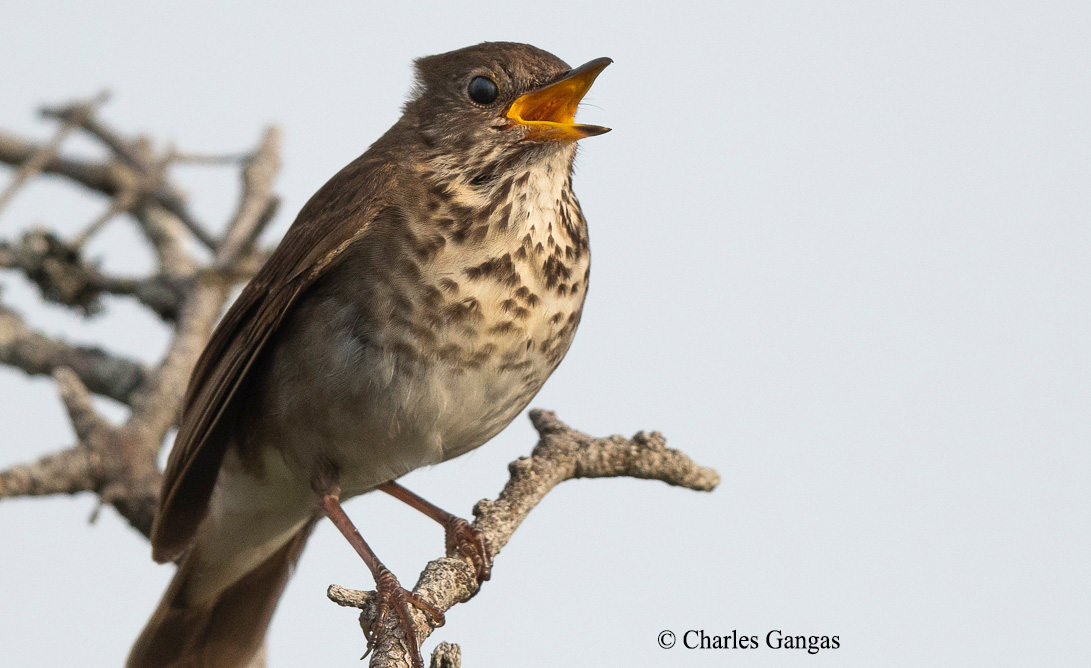Blood Mercury Levels Unchanged Over 18 Years in Mt. Mansfield Thrushes
Mar. 4th 2020Long known as a harmful aquatic pollutant, mercury also accumulates in terrestrial wildlife food webs through atmospheric deposition, especially at high-elevation sites. In the mountains of northeastern North America, mercury deposition is up to five times greater than in surrounding low-elevation areas. Mercury persists in the environment for many years and can transform into methylmercury, a potent neurotoxin that harms fish, wildlife, and humans.
With reported reductions in mercury emissions from 1990 to 2014, partly because of mercury control policies, scientists questioned how mercury levels in wildlife have responded.
Researchers in the Northeast, led by Chris Rimmer of the Vermont Center for Ecostudies in Norwich, Vermont, investigated levels of mercury in the blood of Bicknell’s Thrush and Swainson’s Thrush, long-distance migratory songbirds that spend the summer on mountain tops in New England. Populations of both species are declining, and Bicknell’s Thrush is considered a rare species of global conservation concern.
Rimmer and his team collected data at a long-term study site on the ridgeline of Mount Mansfield from 2000 to 2017. Between 2000 and 2006, the researchers sampled Bicknell’s Thrush, and between 2014 and 2017, they sampled both Bicknell’s and Swainson’s Thrushes. The researchers captured birds with mist nets, banded them, and collected physical data and blood samples prior to release. They resampled many individuals one week or more after the first sample.
The scientists sampled blood mercury from 302 Bicknell’s Thrushes from 2000 to 2017 and 58 Swainson’s Thrushes from 2014 to 2017, mostly from second-year or older birds. They collected and sampled more males than females of both species. There was no difference in blood mercury levels between the two thrush species.
Thrush blood mercury levels ranged from about 0.07 to 0.1 µg/g. Although these concentrations are below those found to harm the physiology and reproductive capacity of similar songbirds, the researchers found that blood concentrations of mercury did not decrease over time as might be expected if mercury emissions have declined.
Atmospheric deposition of mercury, measured at the University of Vermont Proctor Maple Research Center in Underhill, Vermont (750 meters in elevation below the Mount Mansfield study site) increased from 1993 to 2004, decreased from 2005 to 2010, and then climbed abruptly again after 2010. Deposition tended to be highest during July and August.
Although blood mercury levels in the thrushes varied among years, there was no definitive trend up or down over time. Surprisingly, there was no evidence that levels of atmospheric mercury deposition affected blood levels in the birds. Concentrations of blood mercury declined throughout a season from late May into mid-September, and levels in male thrushes were greater than in females. Older thrushes had higher levels of blood mercury than did younger birds.
Rimmer and co-researchers suggest the seasonal decline in blood mercury may stem partly from differences in diet and mercury exposure between overwintering sites in the West Indies and South America and summer breeding sites on Mount Mansfield. During the breeding season, the birds’ diet switches, yet again, from mercury-rich ground invertebrates in the spring to foliage-based arthropods that are lower in mercury content in mid- to late summer. Differences in blood mercury concentrations between the sexes and age groups most likely also relate to diet preference.
Researchers found no real change in blood mercury levels of Bicknell’s and Swainson’s Thrushes over 18 years of sampling on Mount Mansfield, despite regional emissions reductions and local changes in mercury deposition. The scientists suggest that the presence of methylmercury has not changed in this environment over time, highlighting the complexity of ecological processes at work. Rimmer and his team believe that Bicknell’s Thrush remains the most effective bird species for continued biomonitoring of mercury in mountain forest ecosystems of the northeastern United States.
 ecoNEWS VT
ecoNEWS VT